Do you have damp walls in your house?
Haustrocknung.ch GmbH, based in the canton of Bern, has specialized in dehumidifying walls since 2010. This guidebook is about the causes of wet walls as well as effective countermeasures.
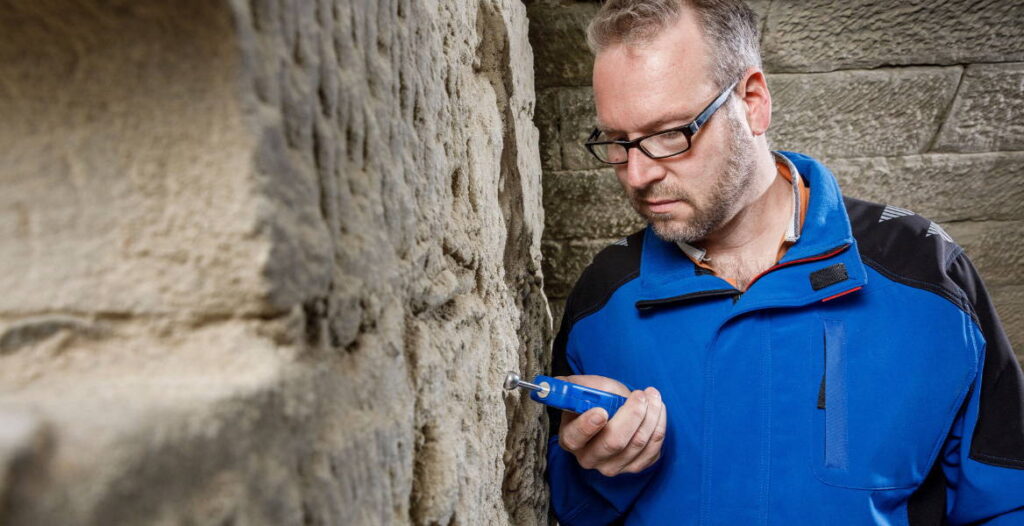
Rehabilitate wet walls
Core statements
- In the case of a damp wall, the origin of the moisture must first be clarified. Possible causes are condensation, rising damp in the wall, defective installations, damage to the building envelope, or an oppressive source of moisture.
- Condensation can be eliminated with intelligent ventilation systems; for rising damp, electrophysical dehumidification is the best solution; for pressing water, an external vertical barrier in combination with a drainage pipe helps.
- In the case of capillary rising damp, the use of dehumidifiers and building dryers can exacerbate the damp problem and lead to damage to the building fabric.
- The horizontal barrier is associated with structural risks because it requires deep intervention in the building fabric and cannot prevent parts of the masonry below the barrier from remaining damp.
- Electrophysical wall dehumidification is able to permanently dry the wall down to the bottom of the foundation because it actively acts on the moisture. However, it is limited in the case of an oppressive source of moisture faster drying after the event.
1. Damp walls, what to do?
In a room with relative humidity above 70 % cool wall surfaces can form mold within a few days. Damp walls also lead to higher heating costs, an uncomfortable indoor climate, musty odors and the decomposition of the building fabric (more about the damages under 3.). This gradually leads to a reduction in the value of the property. It is therefore better to react early. Here you will learn how:
- Measure moisture in the building and determine causes
- Examine and implement effective and environmentally compatible countermeasures
- Perform periodic measurements of residual moisture
First of all, it is necessary to clarify where the moisture comes from. The most common causes are condensation, faulty installations on and in the house, damage to the building envelope and moisture rising inside the wall (more about the causes of moisture under 2.). In most cases, there are several causes that can influence each other. It is therefore advisable to carry out a To engage a specialist to analyze the causes of dampness.
The second step involves examining possible measures to eliminate or mitigate the causes of moisture. People, building fabric, environment and budget should be burdened as little as possible by the countermeasures. Depending on the moisture problem, the following measures can be considered: intelligent individual room ventilation, Building dryer and dehumidifier (only in case of water damage); waterproofing methods, such as horizontal, vertical barriers and electrophysical wall dehumidification; heating systems (more about the measures under 6.).
Thirdly, one or more follow-up measurements should be taken to check whether the measures have actually brought the desired success: Is the entire building fabric now permanently dry? Has the relative humidity dropped to an acceptable level? Has the mold not returned? More about detecting damp walls under 4.
2. Why do walls become damp?
Condensation, faulty installations, damage to the building envelope and rising damp within the wall are the most common causes of damp walls. Pressing water, on the other hand, is a rather rare source of moisture. Often, multiple causes of dampness occur simultaneously. For this reason you should have damp masonry inspected by building experts. The following sections refer to the damage mechanisms of each cause.
Condensation occurs when moist air hits a cold surface, such as the outside of a cool glass bottle. In buildings, this can lead to further damage over time, such as mold growth, musty odors and decomposition of the building fabric. There are many causes of high humidity: incorrect heating and ventilation, water vapor from cooking and drying clothes. In general, ventilation should only take place when it is cooler outside than inside, as warm air can bring more moisture into the house than cool air.
Defective installations on buildings are often responsible for moisture damage. Examples include flat roofs, gutters, downspouts, cisterns and rain barrels. The condition of building components such as bricks, stones, mortar, plaster, wall bases, weatherproof coatings, barrier layers and silicone joints can also play a role. Weak points in the building envelope, such as cracks in masonry, window ledges or balconies; structures that conduct water to the masonry, such as leaky windows, doors, heat exchangers exhaust air grilles, ventilation systems and rain deflectors are other causes.
Capillaries are microscopically small "tubes", gaps or cavities in the building substance. If moisture rises in the building substance via the capillaries, this is also referred to as the "capillary effect". This phenomenon is promoted by the naturally negatively charged wall. Then the building substance absorbs moisture, similar to a sponge.
Oppressive sources of moisture are relatively rare. They indicate that the building was constructed in an unfavorable location. Examples of oppressive moisture include slope water, strata water, or periodically high groundwater, as well as springs or water veins in the vicinity of the building. High levels of seepage water due to heavy precipitation, on the other hand, do not count as an oppressive moisture source.
3. What damage can be caused by damp walls?
Moisture in masonry leads to increased heating costs and a gradual decomposition of the building fabric. Typical damage that can occur in damp masonry is mold growth, musty odor, efflorescence, spalling and rot. The causes of this damage can be attributed to biological, chemical and physical processes.
- Biological processes: Mold can grow in as little as a few days when humidity is high and wall surfaces are cool. Mold is usually accompanied by musty odors and is a serious health hazard to people in the building. Typical symptoms are irritation and allergic reactions of the eyes, nose, respiratory tract and skin; concentration problems, dizziness, headaches, colds and coughs. Molds break down the minerals in the walls, damaging them.
- Chemical processes: Mineral salts enter the building substance with the moisture. These can attack the reinforcement in the reinforced concrete. The resulting rust requires more space and leads to spalling on the wall surface. In addition, moisture can dissolve lime from the mortar or concrete and convert it into calcium nitrate. This leads to systematic weathering of the building fabric. Typical signs of this are efflorescence (light gray spots) on the wall surface.
- Physical processes: Temperature fluctuations in the affected rooms and within the damp walls promote physical damage to the building fabric. When parts of the wall surface freeze, the probability of spalling increases. In addition, salts dissolved in the moisture can crystallize and increase in volume. This increases the pressure in the wall and promotes spalling.
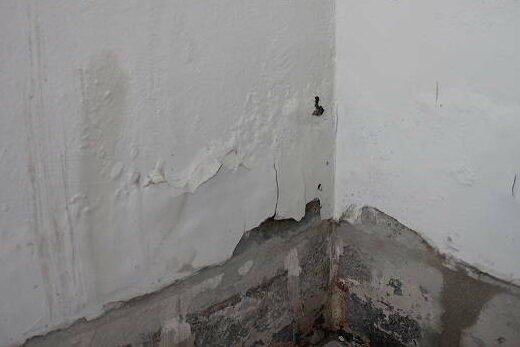
Such spalling is a typical sign of capillary rising damp.
4. How can I recognize damp walls?
Signs of damp walls are stains or discolorations on the wall surface, mold growth, musty odor, paint or plaster flaking, cracks and spalling in the wall, condensation or a damp building substance that can be felt by hand. If you want to know exactly, you can use a moisture meter to qualitatively determine the moisture content of the building substance. In most cases, the surface temperature of the wall provides information about the height to which the wall is damp.
Make sure that you hold the moisture meter perpendicular to the wall. Walls are generally considered dry up to a moisture content of 5 - 6 %. At 5 % - 8 %, it is building fabric with slightly elevated moisture. From 8 % upward moisture is called a damp wall; between 10 % and 14 % is called a wet wall. Walls above this are called very wet and can have a moisture content of up to 20%. In this case, you get wet hands when you touch the wall.
5. Why dehumidifiers can be harmful?
In the case of capillary rising damp, the dehumidifiers lead to an increase in the salinization of the wall. As a result, even more moisture gets into the building fabric in the medium term. In addition to the moisture, other mineral salts can enter the walls and crystallize there. As a result of the salinization, the wall can absorb even more moisture (so-called hygroscopy), which leads to spalling on the wall surface over time, because the salts increase their expansion as they dry out.
Dehumidifiers and building dryers should therefore only be used for a short time immediately after water damage or during the construction phase. On the other hand, they are generally not suitable for long-term dehumidification of old buildings.
6. How to dry damp walls?
Suitable methods are
- Installation of heating and ventilation systems,
- Installation of horizontal barriers, vertical barriers or electrophysical barriers,
- Rehabilitation of structural installations and damage to the building envelope.
The drying method should be adapted to the causes of moisture. Possible causes, are condensation, capillary rising damp or pressing moisture sources. Alternatively, defective structural installations or damage to the building envelope may be the reason for the damp building fabric (more on the causes under 2.). While the defective structural installations must be rehabilitated, you have the following options in case of condensation, rising damp or an oppressive source of moisture.
High humidity and condensation is mostly due to incorrect ventilation or insufficient ventilation. Humidity-controlled ventilation systems can therefore provide a remedy here. For cool wall surfaces, a heating system can help. Horizontal barrier and electrophysical barrier are suitable against rising damp in the wall. In the case of an oppressive source of moisture, the only remedy is usually a vertical barrier, which is usually created in combination with a drainage system that directs water away from the building. These are the methods at a glance:
- Intelligent ventilation systems, such as Cellar vents, Individual room ventilation systems or Solar vents., lead to lower humidity and noticeably improve the indoor climate.
- Ecological heating ventilation and economical heating systems, such as the Baseboard heating, can mitigate the problem of cool wall surfaces. This reduces the risk of condensation.
- As part of the horizontal barrier, a waterproof layer is inserted at a certain height, which bridges the entire diameter of the wall. This prevents moisture from rising.
- The capillary effect is promoted by the naturally negatively charged wall. During the electrophysical barrier a positive electrical potential is induced in the wall. This prevents moisture from rising.
- Vertical barriers can be installed on the outside or inside. In this case, the entire wall is covered with a moisture-impermeable layer. For the outside vertical barrier, the wall must be completely exposed.
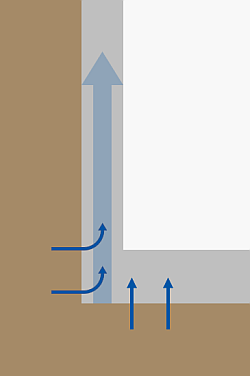
Rising damp
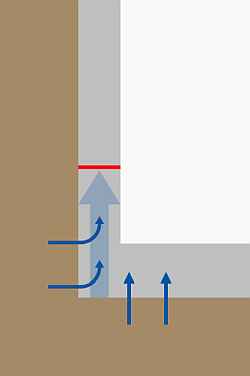
Principle of the horizontal barrier
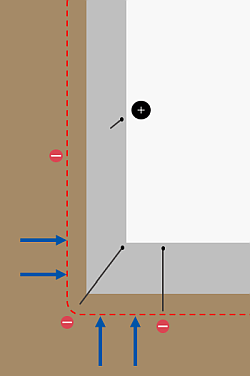
Electrophysical barrier
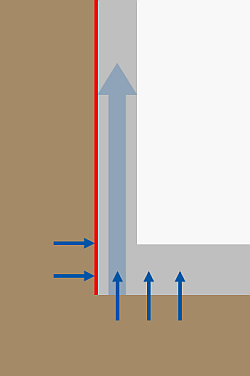
Principle of the vertical barrier
7. What are the advantages and disadvantages of each method?
The dehumidification of walls should be safe, cost-effective, gentle to the building and at the same time healthy for people and the environment. Against the background of these requirements, we will discuss the advantages and disadvantages of the individual methods below.
- Intelligent ventilation systems are inexpensive, very quiet and economical in operation. In addition to effective reduction of humidity, ventilation systems lead to a noticeable improvement of the indoor climate fully automatically. They can also be installed flexibly and with comparatively little effort.
- Heating ventilation, such as the ecological Solar ventilation or auxiliary heating, can effectively prevent condensation and accelerate the drying out of damp building fabric.
- Horizontal barriers can be installed from the inside and reliably prevent capillary rising damp. However, there is a risk that parts of the building fabric below the barrier will remain damp or become damp again. Since the entire wall diameter must be traversed for an effective moisture barrier, this method requires deep intervention in the building fabric, which can also be associated with structural risks and is not reversible. Injection methods sometimes involve the use of sensitive chemicals.
- The electrophysical barrier is scientifically recognized and requires minimal structural intervention. The process permanently dries out the entire building structure down to the basement floor. The process is harmless to humans and the environment. No electrosmog is generated.
- The inside vertical barrier cannot prevent the wall from remaining damp on the outside. The outside vertical barrier, on the other hand, is very complex to implement because the entire wall must be exposed. With the outside vertical barrier, moisture can continue to enter the wall from below. In addition, hermetic sealing of the wall is usually undesirable because the wall can no longer "breathe". Therefore, this method should be used only when there is no other option, such as in the case of an oppressive source of moisture.

Rising damp

Principle of the horizontal barrier

Electrophysical barrier

Principle of the vertical barrier
Ventilation systems are an effective measure against condensation and also lead to a noticeable improvement in the indoor climate. In the case of rising damp, the electrophysical barrier is the safest, most cost-effective and at the same time the most building-friendly method because, compared to the horizontal barrier, it requires only minor intervention in the building fabric and is able to dry the wall completely. If there is an oppressive source of moisture, sometimes there is no other solution than to seal the entire wall with a vertical barrier.
8. How much does electrophysical dehumidification cost?
For a single-family house with a floor area of 60 m², the costs of an electrophysical wall dehumidification with the DRYMAT® system amount to approx. CHF 15'000 to 20'000. This cost estimate includes all necessary steps - from the analysis of the causes to the installation of the system and the follow-up measurement 18 months later. In addition, there are operating costs for the control unit of about CHF 50 per year. Maintenance work, on the other hand, is not required.
By comparison, the cost of dehumidifying the same property using a vertical barrier and drainage system tends to be in the range of CHF 45,000 to 60,000 due to the extensive earthwork involved.


9. Conclusion
In the case of damp walls, the origin of the moisture should first be determined. Possible causes include condensation, rising damp within the wall or an oppressive source of moisture. Alternatively, defective installations or damage to the building envelope may be possible causes of dampness. In most cases, there are several causes at the same time. Therefore, it is worthwhile to commission a specialist with the assessment.
Condensation can be eliminated with intelligent ventilation systems. This simultaneously leads to a significant improvement in the indoor climate. Dehumidifiers, on the other hand, should only be used for a short time immediately after water damage, because they additionally increase the moisture content of the wall in the medium term by intensifying salinization.
Electrophysical wall dehumidification is the safest, most cost-effective and environmentally friendly method of removing capillary rising damp. Compared to horizontal barriers, it requires significantly less intervention in the building structure. In the case of an oppressive source of moisture, the external vertical barrier may be the only effective method. However, due to its high cost, this method is usually used only when there is no other option.

Contact us without obligation
Do you have any further questions or may we prepare an offer for you?
Get in touch with us without obligation. We look forward to your inquiry!
Get in touch with us without obligation. We look forward to your inquiry!
Tobias Bayer
Managing Director
